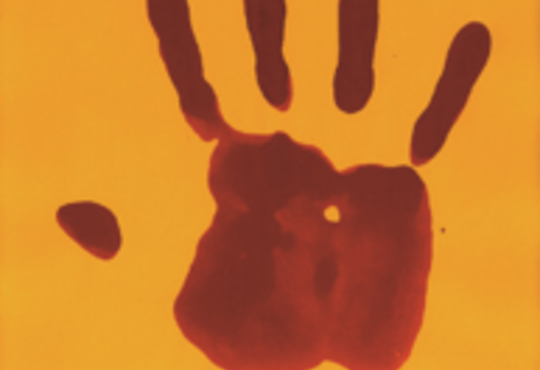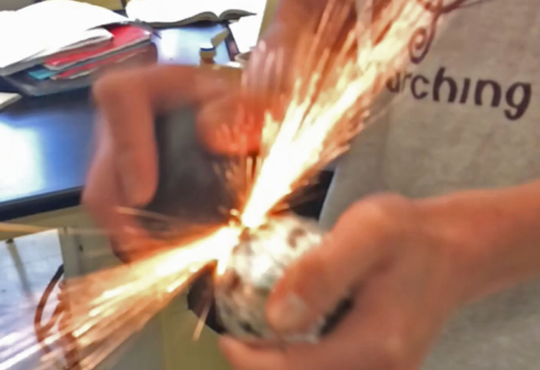The Chemical sunset demonstrates the Tyndall effect in a fun and engaging way. We have used this demonstration for both instructional and outreach purposes. Colloidal sulfur is produced by the reaction between sodium thiosulfate and hydrochloric acid.
Na2S2O3(aq) + 2HCl(aq) → S(s) + SO2(g) + 2NaCl(aq) + H2O
Both the overall chemical equation and the mechanism for the decomposition of sodium thiosulfate are more complex than suggested by above equation. If you are interested, a Flinn Fax — Rate of Reaction of Sodium Thiosulfate and Hydrochloric Acid — details the mechanism and also provides instruction to a reaction rate lab.
As the colloidal sulfur grows larger, successively longer wavelengths of visible light are scattered; while other, even longer wavelengths, are transmitted through the solution. The chemical sunset gets its name from the fact that light transmitted through the solution changes from white to yellow, to orange, to red, to black — similar to the sun setting in the sky.
The demonstration uses an overhead projector as the source of light. The transmitted light is projected on a wall screen or white board while the scattered light can be seen by looking at the side of a crystallization dish that contains the reaction mixture. The platform of the projector is covered with cardboard or dark heavy paper that has a circular hole cut out, the same size as the crystallization dish. The sodium thiosulfate is dissolved in water and then placed on the overhead projector.
After the room is darkened and the projector turned on, the transmitted light appears white while the solution appears colorless when viewed from the side. The hydrochloric acid is then added and briefly stirred in the mixture. As the colloidal sulfur grows the transmitted light changes from white to red and eventually no light is transmitted. All the light is scattered, as can be seen from the side of the dish — it appears as white.
Scenes can be created by attaching an acetate sheet to the cardboard/paper cutout over the hole with tape. Using permanent markers, one can draw any image he/she desires to be projected. We have used a “haunted house” as part of our Halloween show. We’ve determined the quantities of chemicals, including the water, to have the sun set exactly at the end of the song by the Beach Boys Kokomo. Before spring break, we performed this along with a demonstration of sunblock — white cloth held under black light with and without sunblock smeared on. At conferences, we have dressed in beach clothes under our lab coats — once the demonstration started, we took off our lab coats, brought out a beach ball, and began dancing and passing the beach ball back and forth — incorporating the audience in the fun. And it really does not matter whether spring break is near or not.
The chemical sunset
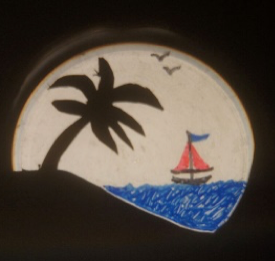
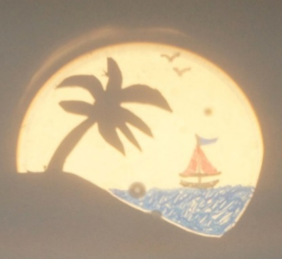
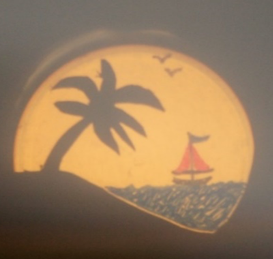
The Tyndall effect creates the appearance of a complete sunset projected on screen.
Concepts
Colloidal solutions, Tyndall effect
Materials
The following list of materials are designed for the size of the crystallization dish used in the demonstration and for the entire length of time to match the song Kokomo — 3.35 minutes.
- 375 mL of deionized water (DI water)
- 2.8 g of sodium thiosulfate
- 25 mL of 1.0 M hydrochloric acid
- Pyrex® crystallization dish, no. 3140, 125 x 65 mm
- Glass stirring rod
- Overhead projector
- Cardboard or dark construction paper that covers entire platform of the overhead projector with a circle the size of the bottom of the crystallization dish cut out
- Acetate sheet with a beach or other scene drawn the same size as the cutout, attached to the cardboard/construction paper. Use permanent markers to prevent smearing, allowing for reuse of the scene year after year.
- Beach Boys song Kokomo, beach props — optional
Safety
-
Wear safety glasses/goggles and gloves.
- Hydrochloric acid is corrosive; avoid contact or ingestion.
- Sodium thiosulfate is an irritant; avoid contact or ingestion; avoid high temperatures — sulfur dioxide and/or hydrogen sulfide can be released.
- Some sulfur dioxide gas is produced during the reaction; perform demonstration in a well ventilated area; avoid inhalation of the fumes.
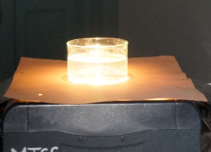
The crystallization dish viewed from the side on the overhead.
Advance preparation
Prepare the cardboard/construction paper cutout. Be sure it covers the entire platform of the overhead projector. The circle cut out should be the same size or a bit smaller than the bottom of the crystallization dish. The beach or other scene is not required but adds to the enjoyment and engagement of the students.
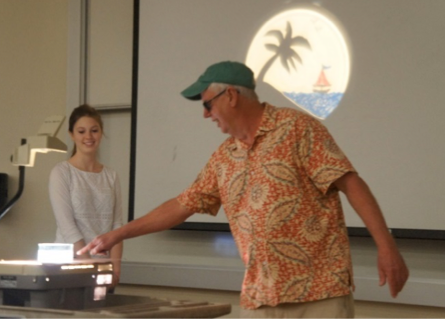
Gabby Hodgins and Ken Lyle showing the chemical sunset. Students are asked to view the petri dish from the side while watching the projected sunset.
If performing this demonstration several times, all the chemical amounts can be measured out in advance. A helpful hint is to measure out and mark off 375 mL of the DI water in one bottle. We washed, rinsed and dried 500 mL commercially available reagent bottles. Using this mark, additional bottles of water were quickly filled with 375 mL DI water. Measured amounts of sodium thiosulfate and 1 M hydrochloric acid were placed in small labeled bottles — enough for each presentation. The sodium thiosulfate can be stored for future presentations. The hydrochloric acid should be measured out the day before or the day of the presentation.
To save time, place the cutout on the overhead projector. The water and sodium thiosulfate can be placed in the dish.
Procedure
For older audiences, colloids and the Tyndall effect is introduced before the demonstration. For younger, a discussion appropriate for their age and background is done after the demonstration.
- Place cardboard/paper cutout on overhead projector. Be sure picture is right side up when displayed on screen or wall.
- Place crystallization dish on the cutout portion.
- Add the 375 mL of DI water.
- Dissolve the 2.8 g of sodium thiosulfate in the water.
- Turn off the room lights and turn on the projector; point out that all the light passes through the solution; none of the light is scattered. Initially the solution when viewed from the side is completely transparent/colorless.
- Add 25 mL of hydrochloric acid, stir briefly and start the music.
- As the reaction occurs, continually have the audience observe both the screen and the side of the crystallization dish, noting the color changes of both.
- By the end of the music, the screen will be black and the solution will be white when viewed from the side
Disposal
The dish contains colloidal sulfur, chloride and sulfate ions. Consult local regulations about disposal.
The following are Erica Weinberg’s thoughts about viewing the Chemical Sunset demonstration as a student.
Dr. Lyle presented “Chemical Sunset” to my Chemistry class at Duke University after the concept of “colloids” had been briefly introduced. The Tyndall effect was difficult to understand without a real world connection. This demonstration was the perfect way to visually observe and solidify a concept. As Dr. Lyle added hydrochloric acid to the sodium thiosulfate, he instructed us to watch both the solution on the projector and the image with the sailboat. After pouring the hydrochloric acid Dr. Lyle hit “play”, setting the mood with Kokomo. It was a powerful learning tool to observe the solution turning from colorless to white — viewed through the side — at the same time that the projected “sunset” took place. This connected the idea that solid particles were forming in the solution through which some light could not pass while other longer wavelengths of light could pass. This resulted in the color changes observed on the screen as the colloidal particles grew larger. It was aesthetically pleasing to watch the “sunset” change from a yellow to orange to red — like a real sunset! Once the “sun had set” and the image on the screen was black — no light passing through — the music stopped in near perfect synchronization. Adding the extra touch of music and an island backdrop also increased enthusiasm of the audience.
A possible inquiry investigation would be to challenge students to synchronize the sunset demonstration with their own music choice. Students need to understand that the Tyndall effect is dependent upon the concentration, size and shape of the colloidal particles, the rate of growth and the path length of the light traveling through the solution. Students could vary the size/diameter of the dish, the length of the song and the amounts of sodium thiosulfate, hydrochloric acid and DI water.
*Erica Weinberg is majoring in evolutionary anthropology with minors in chemistry and psychology. She will go to dental school at Penn State. **Kenneth Lyle, PhD, is a Lecturing Fellow in the Department of Chemistry at Duke University. The Powell Family Trust, Duke-Durham Partnership, and Biogen-Idec Research Triangle Park fund the Duke Chemistry Outreach program.



